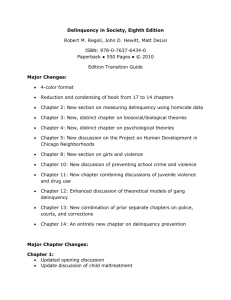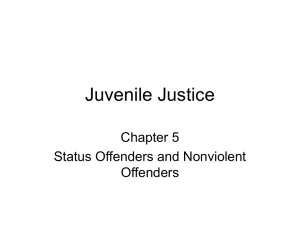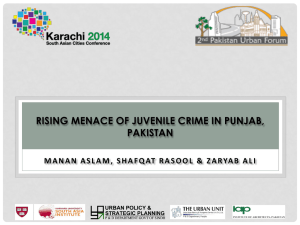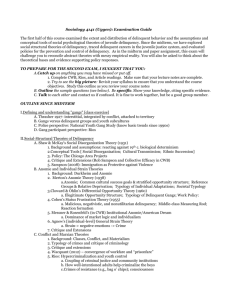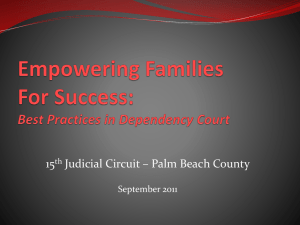course syllabus
advertisement
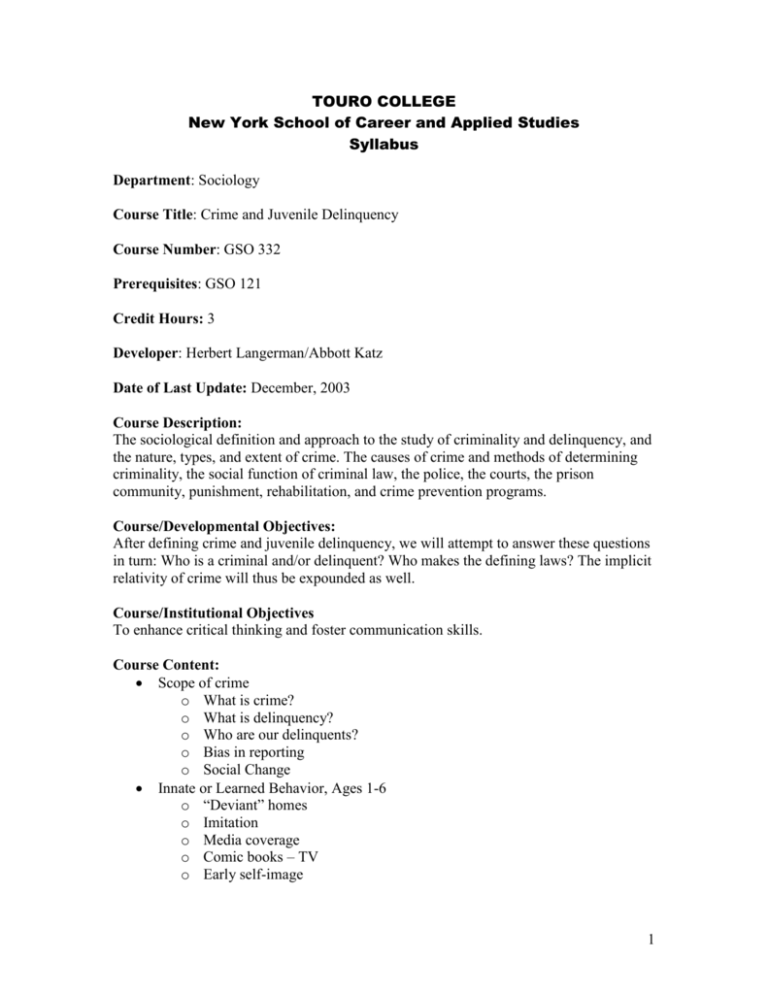
TOURO COLLEGE New York School of Career and Applied Studies Syllabus Department: Sociology Course Title: Crime and Juvenile Delinquency Course Number: GSO 332 Prerequisites: GSO 121 Credit Hours: 3 Developer: Herbert Langerman/Abbott Katz Date of Last Update: December, 2003 Course Description: The sociological definition and approach to the study of criminality and delinquency, and the nature, types, and extent of crime. The causes of crime and methods of determining criminality, the social function of criminal law, the police, the courts, the prison community, punishment, rehabilitation, and crime prevention programs. Course/Developmental Objectives: After defining crime and juvenile delinquency, we will attempt to answer these questions in turn: Who is a criminal and/or delinquent? Who makes the defining laws? The implicit relativity of crime will thus be expounded as well. Course/Institutional Objectives To enhance critical thinking and foster communication skills. Course Content: Scope of crime o What is crime? o What is delinquency? o Who are our delinquents? o Bias in reporting o Social Change Innate or Learned Behavior, Ages 1-6 o “Deviant” homes o Imitation o Media coverage o Comic books – TV o Early self-image 1 Definition of Poverty o Poverty and delinquency o Social class and delinquency o Gender and Delinquency o Welfare Schools and Delinquency o Compulsory education o Vocational schools o “600” schools for disruptive students Truancy and Delinquency o Is truancy a delinquent act? o Why do students become truants? o History of truancy Gangs o Reasons for instilling the “need” for gangs o Peer pressure o Need for recognition and belonging Parents and delinquency o “Normal” family structure o Abusive parents o Absentee parents o Verbal abuse o Structural variants – single/dual-parent families Juvenile Courts o Social change – youths tried as adults o Stigma of prosecution o Confidentiality Juvenile Probation or Incarceration o Pre-sentence reporting o New York City’s Youth House o The Elmira Reformatory Police and Delinquency o Arrests by social class o Arrests by race o Arrests by type of violation Drugs and Delinquency o Need for drugs o Drugs and class o Legalization Decsions by Agents of Control Recording: “Who Killed Michael Farmer?” (July 30, 1957) Hardware/Software/Materials Requirements: No additional requirements; video materials available upon request. 2 Course Requirements Attendance is required. Class participation is encouraged, but no student will be penalized for reticence. Midterm Final Term project Grading Guidelines Mid term exam Term Project Final 25% 50% 25% Methodology The mid term comprises 100 short-answer questions. Term Project: Each student will be required to present a sociological analysis of either a specific area within the juvenile justice system (e.g., juvenile court, arrest procedures, probation, incarceration in a juvenile center, juvenile gangs, sentencing, etc.) or of a specific juvenile-liable act (e.g., truancy, joy riding). The report should span 7-10 double-spaced footnoted pages, and have an adequate bibliography. The paper comprises four sections: o o o o Review of the previous literature Comparison with another culture Field visit report A short critical analysis of your research. All work must be typewritten. Course Texts Senna, Joseph and Siegel, Larry, Juvenile Delinquency: Theory, Pactice and Law, Wadsworth, 7th Edition, 2000 Bibliography Combating violence and delinquency: the National Juvenile Justice Action Plan, Washington D.C.: Coordinating Council on Juvenile Justice and Delinquency Prevention, 1996 . Esbensen, Finn-Aage, Preventing adolescent gang involvement, Washington, DC : U.S. Dept. of Justice, Office of Justice Programs, Office of Juvenile Justice and Delinquency Prevention, 2000. Glueck, Sheldon, Eleanor Glueck, Ventures in criminology; selected recent papers, Cambridge, Harvard University Press, 1964 Miller, Walter B., Violence by youth gangs and youth groups as a crime problem in major American cities , Washington : National Institute for Juvenile Justice and Delinquency Prevention, Office of Juvenile Justice and Delinquency Prevention, Law Enforcement Assistance Administration, 1975 i.e. 1977. 3 Shaw, Clifford Robe, Brothers in crime. With the assistance of Henry D. McKay, James F. McDonald,. with special chapters by Harold B. Hanson and Ernest W. Burgess, Chicago,Ill., The University of Chicago press 1938. Sheppard, David, et al, Fighting juvenile gun violence. Washington, DC : U.S. Dept. of Justice, Office of Justice Programs, Office of Juvenile Justice and Delinquency Prevention, 2000 Wolfgang, Marvin E., Leonard Savitz, Norman Johnston, The sociology of crime and delinquency, New York, Wiley, 2d Edition 1970. 4
